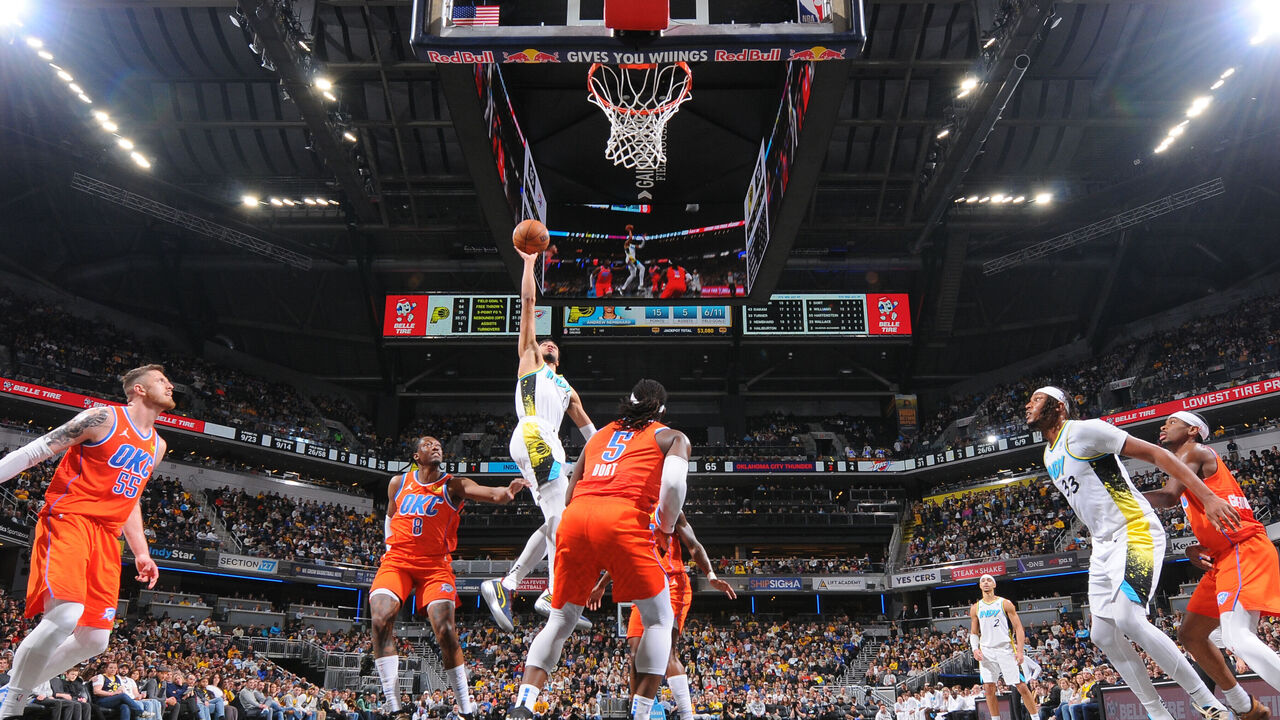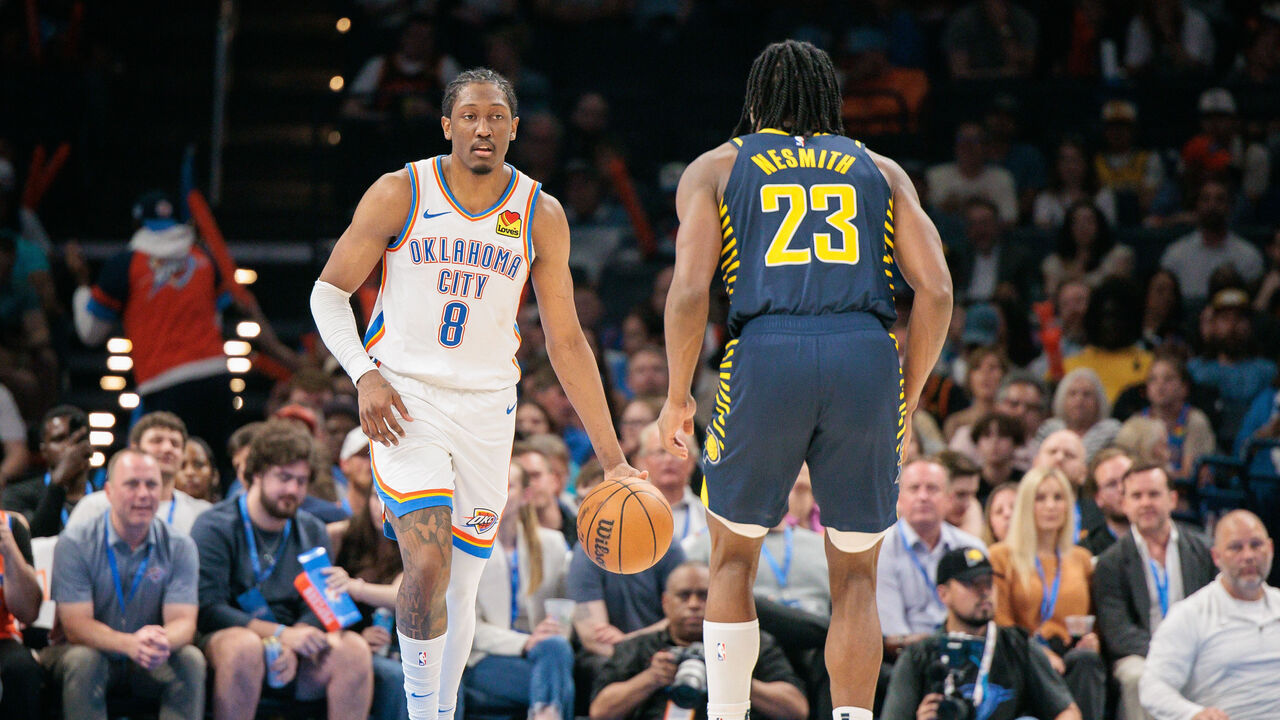The 3 battlegrounds that will decide the NBA Finals
The NBA campaign has finally reached its endgame, with the Finals set to tip off Thursday night. In one corner, we have an abnormally young, defensively impenetrable Oklahoma City Thunder team that's been historically dominant all season and boasts the league MVP. In the other corner, we have a swift, surging Indiana Pacers squad that's been on a magical run this postseason, powered by one of the most gifted and creative point guards in the game.
Here are the key three tactical battlegrounds that will help determine who wins the series.
Turnover control vs. transition runouts
This matchup pits two of the NBA's most judicious offenses against two of its most aggressive ball-pressuring defenses.
The Thunder combined those two elements to a historic degree during the regular season, ranking first in offensive and defensive turnover rate, racking up more steals than any team in the 21st century, and posting the best turnover differential (plus-5.3 per game) of all time. That differential has gotten even more dramatic (6.2) in these playoffs.
The Pacers aren't at the same level, but they're no slouches, having turned the ball over at the league's third-lowest rate while turning opponents over at the 12th-highest rate during the season. Their rates have held steady during the playoffs.
For both teams, ball protection is largely a byproduct of their brilliant point guards, Tyrese Haliburton and Shai Gilgeous-Alexander. Haliburton and the Pacers manage to limit turnovers despite throwing more passes than any team in the league besides Golden State, while Gilgeous-Alexander and the Thunder do so while playing a lower-risk, more iso-heavy brand of offense. (They pass about 60 fewer times per game than Indiana.)
The teams' defenses also apply pressure in different ways; the Pacers pick up ball-handlers in the backcourt more often than any other team, while the Thunder swarm drives, passes, and post-ups in the half court (not that they're at all averse to full-court pressure).
A lot hinges on which of those entities wins out in this series, because OKC and Indiana are exceptionally good at turning takeaways into points. They rank first and third in points added via transition play this postseason, per Cleaning the Glass. As the clear underdogs in this series, going up against one of the most ferocious defenses we've ever seen, it's going to be particularly important for the Pacers to take care of the basketball - to be crisp with their actions, precise with their passes, and tight with their handles.
Haliburton can be relied upon to do that, and Pascal Siakam (who's turned the ball over just 1.1 times per game in the playoffs) probably can be as well. But one of the main features of OKC's defense is its ability to funnel the ball from sure-handed stars to mistake-prone role players. Which means guys such as Andrew Nembhard, Myles Turner, Aaron Nesmith, T.J. McConnell, and Bennedict Mathurin have to be fully prepared to face a level of pressure they haven't yet seen.
If the Pacers can withstand that pressure and avoid the costly giveaways that have torpedoed every other Thunder opponent so far, they might have a glimmer of hope.
Pacers vs. Thunder's half-court defense

If they can't pry the ball away from Gilgeous-Alexander and Co. to kickstart their deadly transition attack, the Pacers will have to try to score against the Thunder's set defense. In those contained scenarios, it's going to be a best-on-best battle: Indiana's top-ranked half-court offense (which has produced 105.8 points per 100 possessions in the playoffs) against OKC's top-ranked half-court defense (which has allowed just 88.6 points per 100). Rarely has such an unstoppable force met such an immovable object.
All the spacious lanes Haliburton's enjoyed dancing through to this point, the passing angles he's created and exploited, the mismatches he's hunted, the different ways he's managed to put opposing defenses in rotation ... all of that is about to dissipate. He's going to have to deal with the likes of Lu Dort, Alex Caruso, and Cason Wallace hounding his every move, face-guarding him, chasing him around screens, swiping at his dribble, bumping him off his line, and jamming him up when he tries to get free off pindowns. He's going to see a whole buffet of pick-and-roll coverages, including a ton of switches. And OKC's army of help defenders will track him wherever he goes, darting in and out of his path at every turn.
As great as Haliburton is, he can lapse into passivity against those kinds of specialized coverages, and that's been an issue for him against the Thunder in the past. His usage rate in the teams' two head-to-head meetings this season was 13.5%, his lowest against any opponent. That mark would rank him 10th among Indiana's rotation players this postseason, right between Jarace Walker and Thomas Bryant. He also averaged only 5.5 assists, and though he satisfied the ball-control requirement (turning it over just once in the two games), that wasn't enough to offset his lack of offensive involvement. Needless to say, he needs to be more assertive in this series, even if it means more mistakes.
The rest of the Pacers will also need to be ready to pick up the slack, starting with Siakam. His individual matchups won't be any easier - he'll have to deal with the likes of Chet Holmgren and Jalen Williams with doses of Dort and Caruso sprinkled in - but he'll at least have some size mismatches to hunt (Gilgeous-Alexander being his best bet) and will have opportunities to capitalize when OKC sends aggressive help in Haliburton's direction.
Indiana's role players are also going to have to take advantage of that attention by continuing to knock down their threes. This has been by far the best 3-point shooting team in the playoffs (40.1%), and the Thunder defense has allowed the fourth-highest opponent 3-point attempt rate - and second-highest corner 3-point rate - of all postseason teams. That's the consequence of all their paint-packing, stunting, doubling, and pre-rotating in the middle of the floor.
They've gotten away with it to this point because their opponents have shot just 33% from deep. If the Pacers can make the Thunder pay, by zipping the ball around faster than they can rotate and by drilling the clean outside looks that materialize as a result, maybe all that traffic in the lane will start to clear up a bit.
Indiana's defense vs. SGA's co-stars

No team has much hope of stopping or even slowing down Gilgeous-Alexander, the craftiest, most versatile, most relentless scorer in the league. If Minnesota's perimeter defenders couldn't make a dent in his armor, Indiana's probably can't either.
Nesmith is likely the best man for the job in this series, but he's nursing an ankle sprain that could make it even tougher than it already would've been to stay balanced while trying to mirror Gilgeous-Alexander's frictionless changes of pace and direction. Nembhard will get his share of cracks at that assignment, but he'll be giving up some size in the matchup. Every other Pacer is either too small or too slow to have a chance. All of which is to say, "keep a lid on the MVP" can't really be part of the Pacers' roadmap to victory here.
That obviously doesn't mean they're going to throw their hands up and let Gilgeous-Alexander do whatever he wants. They'll do their best to make up for the limitations of their individual defenders with team schemes that force SGA to play in a crowd. They'll work to get the ball out of his hands, vary their coverages to keep him on his toes, and try to scramble his decision-making as much as possible. At the end of the day, though, Indiana's best hope of slowing down an offense that's proven to be vulnerable at points in these playoffs is to limit the rest of the Thunder.
Some of that will simply be decided by the whims of jump-shooting variance. Denver pushed OKC to seven games largely because none of the Thunder's role players could hit a three and Jalen Williams couldn't make a mid-range pull-up or a layup for six games. That changed against Minnesota, but it wasn't because the Timberwolves played worse defense than the Nuggets did.
At the same time, the Nuggets' heavily used zone defense was a knuckleball that clearly threw OKC out of rhythm, and their decision to guard Holmgren with wings proved effective at tamping down his offensive impact. Whether or not the Pacers pull those specific levers, they'll need to be open-minded and creative in their defensive approach.
That might mean doing something they've been loath to do this season and cross-matching Turner onto a low-usage wing (like Dort or Caruso), while letting someone such as Nesmith take the Holmgren assignment. Maybe it'll mean amping up their switching and showing minimal help to try to make Gilgeous-Alexander a one-man show and turn his co-stars into bystanders.
No solutions are perfect - every non-zone option leaves the difficult questions of who guards SGA and where Haliburton hides - but the edict should be clear: Get funky, throw a bunch of different pitches, and see if anything can catch the Thunder on the wrong foot.
Joe Wolfond writes about the NBA for theScore.